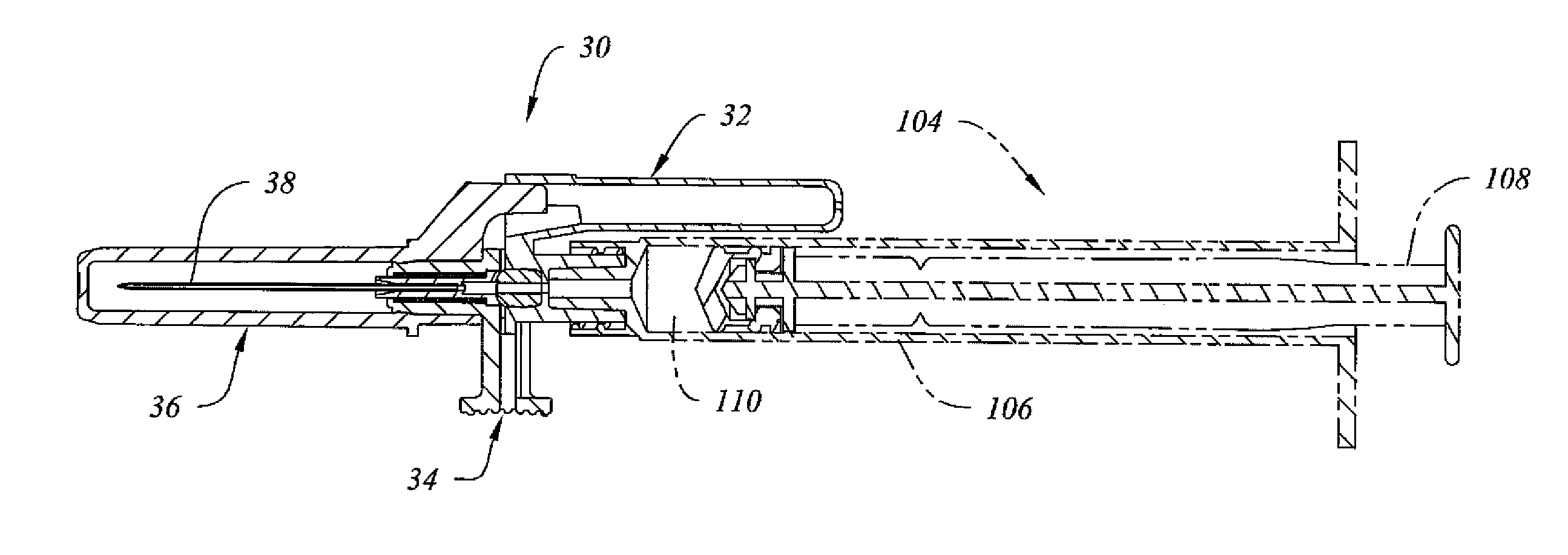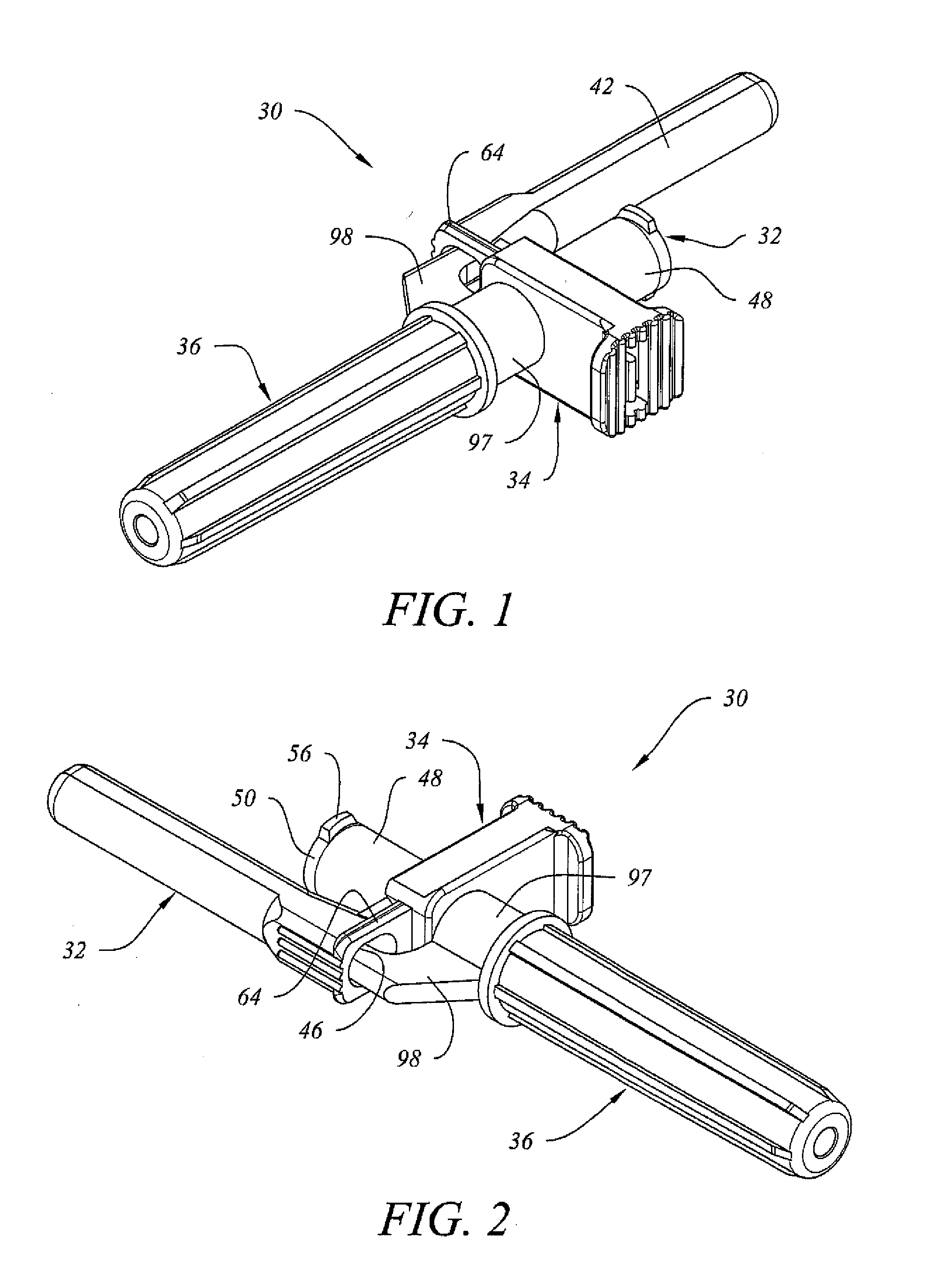[0018]The connector housing desirably further comprises a needle retraction chamber having at least one unobstructed, forwardly facing, open end communicating with a rearwardly extending needle retraction cavity. If desired, a small vent can also be provided at or near the rear end of the needle retraction cavity. The connector housing is desirably unitarily molded together with at least a part of the associated medical apparatus, although other substantially rigid attachment means such as adhesives, plastic welding or the like can also be used to join a part of an associated medical apparatus, such as a syringe barrel, in a substantially fixed positional relationship to the needle retraction chamber of the connector housing. Whether the connector housing is unitarily molded together with or is otherwise attached to and made an integral part of at least a portion of the associated medical apparatus, the connector housing desirably establishes a substantially linear fluid flow path between the associated apparatus and the needle holder (without the need for cross-over channels or the like), thereby reducing the pressure required to move fluids from one to the other as compared to a non-linear flow path as might be experienced in a device having a cross-over channel between a fluid chamber and the retractable needle.
[0019]A fluid seal is desirably disposed between the frontal attachment and the connector portion of the connector housing, and is seated in a recess disposed in coaxial alignment with the connector portion of the connector housing in coaxial alignment with the needle prior to retraction. In one embodiment of the invention, the fluid seal is annular and is movable so that it remains aligned with the connector portion of the connector housing and is repositioned into facing contact with the rear of the body of the frontal attachment as needle retraction is initiated. The annular fluid seal desirably surrounds the fluid flow path between the connector housing the body of the frontal attachment prior to needle retraction and restricts fluid leakage between facing surfaces of the body and connector housing prior to, during and after needle retraction. The needle retraction cavity inside the needle retraction chamber of the connector housing is initially offset from the longitudinal axis through the needle but is desirably moved laterally into substantial alignment with the needle axis during needle retraction. A locking needle cap is desirably provided to prevent premature activation of the needle retraction mechanism during packaging, shipping and handling, and to protect the needle tip from being blunted, bent or otherwise damaged prior to use.
[0021]When the opening into the retraction cavity is sufficiently aligned with the head of the needle holder to receive the needle holder into the needle retraction cavity, a biasing member such as a compressed coil spring disposed in the body propels the needle holder and needle rearwardly, simultaneously withdrawing the beveled front tip of the needle so that it no longer projects forwardly from the body of the frontal attachment. As the needle retraction chamber slides laterally relative to the needle, the annular fluid seal reduces the likelihood of any fluid leakage from the subject medical device due to fluid flow out of the associated medical apparatus following use.
[0022]The subject medical device provides numerous benefits and advantages when compared to prior art devices. Once such benefit is that needle retraction can be activated independent of aspiration so that, for example, fluid can be withdrawn from a knee and the needle can still be retracted without fully depressing the plunger handle. Another benefit is that the subject medical device is configured to retract the needle directly from a patient without first having to manually withdraw the needle and risk possible contamination by exposure to bodily fluids containing infectious pathogens. Needle retraction can also be initiated following injection of a partial dose. Greater control can be exercised by the clinician using the invention because retraction is initiated by applying pressure closer to the base of the device, thereby reducing the likelihood of needle “wobble” in the patient.
[0025]The frontal attachment of the invention can also be used with needles and syringes of different and varying gauges and sizes without special modification. If desired, either the associated medical apparatus with which the subject medical device is used, or the medical itself, can be provided with a plug containing an anticoagulant such as heparin to use in blood gas applications. The structure and operation of the invention are simplified by the provision of a substantially linear fluid flow path and a needle retraction chamber and associated retraction cavity that are offset laterally from the fluid flow path during fluid injection or extraction. The subject medical device has few parts, and those are easily and inexpensively molded.
[0026]The medical device of the invention also embodies safety features that are not typically available in many prior art devices. For example, the subject device is effectively “locked shut” against reactivation and reuse by the spring and needle that bridge the needle retraction cavity and body together following retraction. The sliding lateral movement and associated repositioning of the needle retraction cavity relative to the fluid flow path through the connector housing and the presence of a fluid seal between the body and connector housing cooperate to interrupt the fluid flow path and prevent fluid backflow from an associated medical apparatus following use. After the needle is retracted, the subject medical device can be removed from the associated medical apparatus and disposed of as with other needle covers. In circumstances where the associated medical apparatus is reusable, it can be autoclaved, sterilized or otherwise processed for possible reuse independently of the needle-containing component.
 Login to View More
Login to View More  Login to View More
Login to View More 


